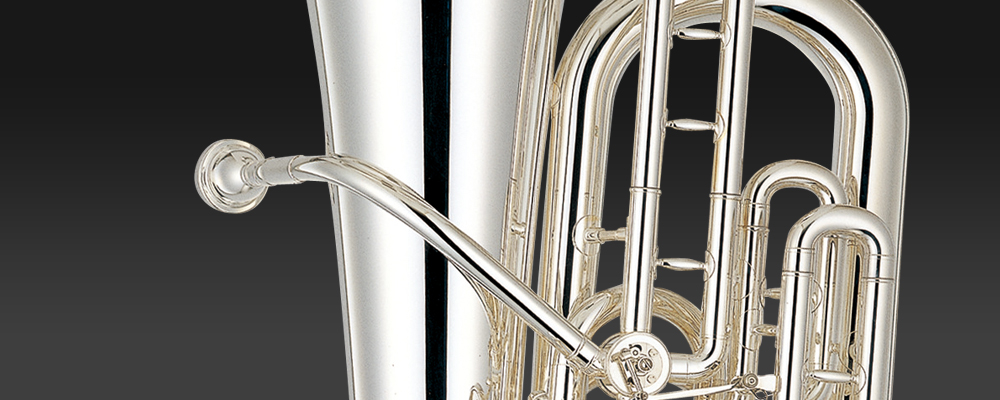How to Play the Tuba
Key Insights for the Tuba Player
Can smaller people and women play the tuba?
You may have heard that the tuba is not suited to smaller people or those with less robust lung capacity. However, this is not necessarily true. To be sure, the tuba requires more lung capacity than a clarinet or trumpet, but it pales in comparison to the flute. There are women of small physical stature who are professional tubaists. Anyone with normal lung capacity is encouraged to give it a try.
Lung capacity can be increased through deep breathing
There is no denying that having greater lung capacity is an advantage for playing larger tubas. Dedicating some time to daily training can assist with increasing your lung capacity. The ideal approach would be to adopt an exercise habit like swimming or jogging. If this is not feasible, you might want to try deep breathing practice called "abdominal breathing." If you practice breathing by using your abdominal muscles to fully exhale to the bottom of your abdomen, you will boost your lung capacity while also increasing control of your breath.
(Source: Dictionary of Fun Facts on Orchestral Instruments [in Japanese], published by Yamaha Music Media)
Is there a delay before you hear sound from the tuba?
Since the tubes of a tuba are quite thick, the instrument contains a considerable volume of air. This makes the initial vibrations sustain and reverberate. For example, if you play a C note followed by a D, the C will linger and you will need to stop playing it slightly sooner than other instruments. If you do not, the timing of the D note will not match the players around you. Furthermore, a little more time is required for the sound to emerge after you start playing. This delay, however, becomes second nature for a tubaist. Once accustomed to this timing, a tuba player hardly even notices when switching notes slightly earlier than other musicians.
Borrow a desk or chair when setting down your tuba!
It is common sense to rest a tuba on a flat, sturdy surface with the bell facing downward. Even so, there is no guarantee that your tuba will be safe from damage to the bell (however slight), or perhaps even worse, if you stand it on the wrong surface, if someone bumps into it, or if another accident occurs. In extreme cases, your damaged tuba will no longer be able to play any notes at all. When placing your tuba on the floor, use a desk or chair to ensure that it will not tip over easily. Keep this in mind whether you are in the music room or preparing for a performance!
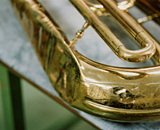
A dent severe enough to block any sound
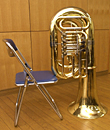
Use a chair to support the tuba
Be sure to hold it in the right place
The heaviest tuba (a B♭ tuba) weighs between nine and ten kilograms. If you mistakenly hold the instrument by the delicate slides, they will bend under the instrument's weight. Instead, hold the tuba by the thick outer tube or grip a wide area so that the weight is distributed across more than one point. Players sometimes hold the bell when bowing or standing up. If you do this, be sure to set the instrument down and balance it with a flat, open hand, rather than gripping the edge of the bell at one point.
Make sure the slides are oriented correctly
Can you spot the difference between these two photos? The slides are pointing in opposite directions. With this tuba model, the slides can go on forwards or backwards, which some people have been know to do just for fun. But it can have terrible results! If the case will not shut properly and someone forces it closed, the tubes can be crushed. Be sure to put the slide on in the right direction.
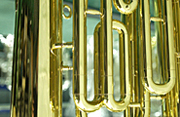
A slide pointing in the right direction
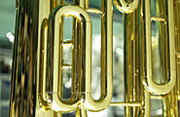
A slide pointing in the wrong direction
*For Yamaha's models YBB-201II and YBB-321II, the third slide can be damaged if it is facing the wrong direction when returning the tuba to its case. Be sure to take good care of your instrument.
What is the difference between piston and rotary valves?
Piston and rotary valves can affect how easy it is to modulate the instrument's sound by adding slurs or changing the timbre. Many people say that piston valves are suited to softer play, while rotary valves are better when you want clearly separated notes.
Musical Instrument Guide:Tuba Contents
Origins
Structure
How to Play
How the Instrument is Made
Choosing an Instrument
Trivia
- A Massive Tuba from 100 Years Ago
- Depending on the Country, a Baritone is Not a Baritone
- The Cinbasso-Popular in Italian Opera
- All Brass Instruments Have Marching Band Models
- Famous Musical Pieces for the Tuba (Bass)
- The Compensating System for the Euphonium
- There are Various Mutes for the Tuba
- Ease of Playing Pedal Tones
- Why Are Tubas So Expensive?
- Do Jazz Musicians Play the Tuba?
- Brass Band Songs Featuring the Tuba
- An Instrument in the Key of B♭, Yet the Music is Written in C

